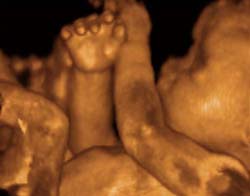As social media has completely revolutionized the way we communicate and share ideas, it has also given a voice to those among us who have no voice, the unborn.
Facebook’s 750 million users now have the option of adding family members still in the womb to their list of “Friends and Family” on their profiles — with “Expected: Child.” They also have the option of adding a photo of their unborn baby, the baby’s name and a due date.
 In a clear display of humanity, the unborn child is listed right alongside born family members, emphasizing that each member of the family is equally important and valuable. Once added, a notification is posted to the newsfeeds of all of the user’s friends, giving everyone a chance to witness and celebrate the new human life.
In a clear display of humanity, the unborn child is listed right alongside born family members, emphasizing that each member of the family is equally important and valuable. Once added, a notification is posted to the newsfeeds of all of the user’s friends, giving everyone a chance to witness and celebrate the new human life.
With innovative technology like 4-D ultrasounds, iPad apps and social media to shine a light on the humanity of the unborn child, it is no wonder young people are more pro-life than the previous generation. The General Social Survey, which has collected opinion data on abortion using the same line of questioning since the 1970s, found that in most years, respondents between the ages of 18 and 29 tended to be the least sympathetic age group toward the pro-life position. However, that all changed around the year 2000 when the General Social Survey has found that those between the ages 18 and 29 have actually become more pro-life than their parents.
The current generation of young people grows up with an ultrasound printout as their first baby photo. They have a wealth of scientific information at their disposal previously unknown to older generations. You’d be hard pressed to find a young person who has taken a basic biology class that still believes life begins at birth as the Supreme Court did in 1973.
 Young people have also dropped the prevailing stigma against teen and single motherhood that existed decades ago. Most young people have a friend or family member their age currently raising a child. Removing the social taboo of caring for a child has helped protect young mothers from a familial and societal pressure to abort.
Young people have also dropped the prevailing stigma against teen and single motherhood that existed decades ago. Most young people have a friend or family member their age currently raising a child. Removing the social taboo of caring for a child has helped protect young mothers from a familial and societal pressure to abort.
Young people also have more viable alternatives to abortion available to them than ever before. Currently, there are an estimated 4,000 pregnancy resource centers nationwide compared to about 2,000 abortion facilities, according to the National Abortion Federation. Some states like Pennsylvania, Texas and Minnesota even provide state funding to pregnancy resource centers to empower young mothers facing difficult pregnancies. Some college campuses have even worked to make their campuses mother-friendly, offering on-campus housing for mom and baby and maternity coverage in their health insurance plans.
While the pro-abortion movement targets young people for abortion and for political support, their efforts are falling on deaf ears as they continue to lose ground. NARAL Pro-Choice America’s President Nancy Keenan admitted upon witnessing the 2010 March for Life, “I just thought, my gosh, they are so young. There are so many of them, and they are so young.”
With technology and social media exhibiting the humanity of the unborn child before the masses, the abortion debate shifts from a question of whether a human life is present in the womb to whether he or she deserves the same legal protection as everyone else.







